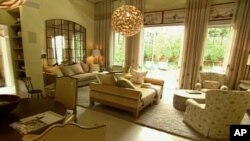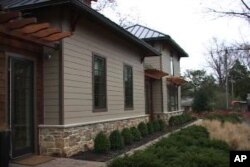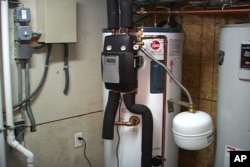The average home in the United States produces more than seven metric tons of carbon dioxide, or CO2, each year - just from electricity use. That adds up to around 17 percent of all the carbon emissions coming from the U.S. While Americans may want to live a "greener" lifestyle, many are unwilling to give up any of the modern conveniences that make a house a home. Now a new model home in suburban Washington, D.C. shows they can do both.
"We wanted to build a house that showed that sustainability and live ability really go hand in hand," says home builder Mark Lowman. His firm, the West Group, built the house in McLean, Virginia, using the latest high efficiency appliances, energy technology and sustainable materials.
"The house should produce enough electricity to take care of the requirements of the family," says Lowman. "On days when they're consuming more than the house is able to produce, we're buying it from a local power provider using their renewable energy sources. But for the most part, on a day that we have plenty of sun, the house should be providing more than enough energy for the family to live here comfortable, without having to buy any from the power grid."
Consideration about its carbon output even went into the building of the house, which features recycled materials and local products like the stone used for the foundation. The brick pathway - also from a local manufacturer - helps sustain the native plants in the landscaping.
"The sidewalk is manufactured by a company called Belguard, right here in Gainesville, Virginia," notes Lowman. "This is 100 percent permeable paver. We're using Forestry Council cedar on the siding. In between the three pavilions, there are two green roofs. All of the wood materials for the woodwork, cabinetry, any sort of built-in, were constructed using formaldehyde-free, chemical-free, woods and materials and finishes."
The house is touted to be the first carbon-neutral home on the U.S. east coast. Even with a state-of-the-art kitchen, the home normally produces more electricity than it uses. Power for the 1,200-square-meter structure is possible through solar panels and wind turbines. A geothermal system provides heating and cooling, the plumbing features low flow water fixtures, and there is a rain capture system.
But all of these features together add up to a large price tag. The house was listed for sale for more than $2 million. But the West Group's Mark Lowham says a homeowner can still significantly cut down their carbon footprint by making just a few changes.
"I probably would invest in a solar hot water system. It's very, very efficient and relatively inexpensive," he says. In addition to helping to save the climate, the McLean green home contributes to some local charities through the proceeds from tours of the interior.
You can see all of Rebecca Ward's episodes of "Going Green" here.






